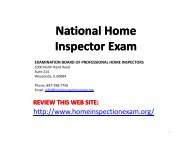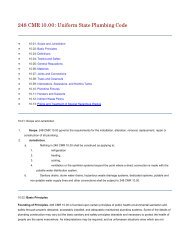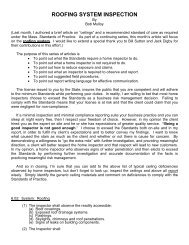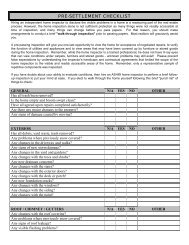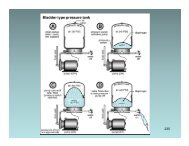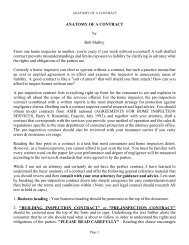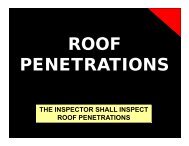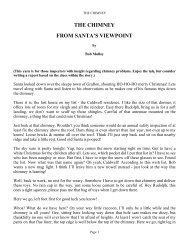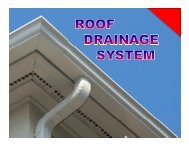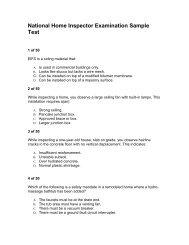Red Flags In The Attic - Allsafe Home Inspection Service, Inc.
Red Flags In The Attic - Allsafe Home Inspection Service, Inc.
Red Flags In The Attic - Allsafe Home Inspection Service, Inc.
- No tags were found...
You also want an ePaper? Increase the reach of your titles
YUMPU automatically turns print PDFs into web optimized ePapers that Google loves.
RED FLAGS IN GRANDMARED FLAGS IN GRANDMA’S ATTICByBob MulloyEvery home has some kind of space above the top floor and we, ashome inspectors, are called upon to inspect it. <strong>In</strong> this article, I plan toshare my attic inspection methodology, touch on few examples ofdefensive report writing and alert you regarding typical "red flags towatch for."While not perfect, I do follow a practiced routine or methodology whenobserving & evaluating the attic. For the home inspector, amethodology is defined as: "a practiced order of discovery that toucheson all important components." A professional home inspector mustutilize an efficient methodology throughout the entire inspectionprocess so as to service the needs of the client in a manner that preventserrors & omissions.Where to start? Firstly, (C.Y.A.) your report should document what you"did or did not do, what you could or could not see and why." Forexample:...."due to closet obstructions and stored goods within theattic, the attic was only viewed from a step ladder with myhead through the hatch, using a flashlight. <strong>The</strong> attic wasNOT entered...."...."be advised that because I could not enter the attic,hidden problems may exist that are not documented in thisreport. When clearances or obstructions are improved, Irecommend that you fully examine each attic space prior tocommitment. If your research reveals any suspicious areasPage 1
RED FLAGS IN GRANDMAof concern, then you should call me for consultation orschedule an optional return visit inspection...."Report writing, as listed above, documents what you did, what you didnot do and gives your client direction while protecting your backside.<strong>The</strong> next step is to follow your methodology of inspecting all importantcomponents while on the look-out for red flag areas or other concerns.Each observation should be accurately documented in your report perthe ASHI® Standards of Practice, but don’t forget the simple layman’sexpectations of your client. Most uneducated buyers want the answersto simple questions such as:Does the roof leak?Are there any signs of decay?Is the attic insulated?Will I have room for storage?Certainly you should inspect all key areas and alert your clientregarding important concerns, but if you fulfill your clients basicexpectations by answering the above questions, you will have gained afriend also.While still at the hatch, I first check for bees or nasty critters thatjeopardize my personal safety. (Note: Through personal choice, some home inspectors wear a respiratorwhen entering the attic. I am guilty of not wearing one and I am well aware of the potential exposure hazards. However, therespirator debate can be saved for a future article.) Once the entrance is deemed clear ofhazards, my mag-light becomes my third eye.I flash the beam on every accessible component allowing the categoriesof my methodology to overlap. <strong>In</strong> other words, while viewing theaccessible members of the roof frame, I am also alert for red flags inthe areas of water infiltration, insulation & ventilation. Any suspiciousitem that catches my eye results in a closer scrutiny with the flashlightPage 2
RED FLAGS IN GRANDMAand an up close & personal investigation when warranted andaccessible.If the home has full head height, then my preference is always to enterthe attic to see beyond the storage or around the other side of thechimney. Yes, I also get lazy about entering the attic through a difficulthatch, but usually my sub-conscience wins out and I enter only toobserve a problem that I would have missed otherwise. <strong>In</strong> my mind is apicture of associated exterior concerns, such as a wavy roof frame,missing vent pipe or lack of ventilation. I like to leave the bathroom fanrunning to easily locate it within the attic.<strong>In</strong>specting the structure is my first order of business. I follow the beamof the mag-light across every structural component and also test byprobing & sounding when warranted. While not performing a codecompliance inspection, I evaluate the materials, condition, method ofassembly, workmanship, fastening, size, span, alterations, violations,etc. <strong>The</strong> following is a brief list of structural "red flags": (Note: This is not acomplete list, I’m sure you can add to it.)Ridge board: sags, improperly spliced, undersized for rafter cut, too small, spaced to far etc., spreading at ridge, crackedor sagging, decayed from suspected pest infestation, decayed from suspected water infiltration.Rafters: decayed from moisture within non-vented attic, rafters not in alignment at ridge board, rafter or truss cut oraltered without header, rafter excessively notched, rafter bird mouth over- cut, rafter nailing schedule not adequate,rafters charred from past fire.Roof sheathing: decayed, delaminated, sagging, erupted, broken boards or holes, improperly nailed, weak or spongywhen walked on, sheathing FRT. plywood problems.Hip or valley rafter broken, or spliced.Ceiling joist cut without adding header. Ceiling joist sag, decayed, cracked, broken, undersized, excessively spaced.Truss lift, solid blocking missing at end of trusses.Adjoining roof planes misaligned.Sag in flat roof structure. Wavy roof appearance.Structural beam questioned at cathedral ceiling.Struts do not bear on bearing wall, struts undersized broken or loose, purlins cracked or broken.Page 3
Improper framing at skylight, pull-down stairs or attic fan.Missing or incomplete fire shielding at party wall.RED FLAGS IN GRANDMAVentilation red flags are "frequent flyers" for the home inspector.My methodology for evaluating the ventilation of the attic spacesfirst begins outside where I note the presence or absence of atticvents, their types and locations. I tuck that knowledge away until Iget into the attic and then I re-examine each vent for condition.Regardless of codes that require specific minimum amounts ofattic ventilation, I also rely on my senses & observations whileanswering one simple question: Does the present amount of atticventilation appear functional in terms of adequately removingmoisture and trapped heat from the home? If problems aresuspected, then I alert my client accordingly. If the system isfunctional but does not comply with modern constructionpractices, then I discuss optional ventilation improvements. <strong>The</strong>following is a brief list of ventilation red flags:No attic ventilation, blocked vents., slots not cut wide enough at ridge vent., Imbalanced ridge vent - no lower ventilation,<strong>In</strong>sulation blocks ventilation at soffit, Styrofoam baffles missing, loose, displaced., damaged vents., mildew in attic,delaminating roof sheathing at northerly side, frost in attic, rusted nails & rust stains on sheathing near nails, circularstains on floor boards, bathroom fan discharges into attic, hole too small for attic fan, amateur attic fan installation andwhole house fan warning - potential back-drafting problem.<strong>In</strong>sulation & vapor barrier red flags also are prevalent in the attic.Perhaps one of the most important things I always do is to lift upor dig through a piece of the insulation to see what laysunderneath. By looking under the insulation I verify the presenceof a vapor barrier and identify the types of insulation that may besandwiched together. Sadly, I find that the vast majority of existinghomes in the northeast are not properly insulated, lack a vaporbarrier and have insufficient ventilation. So much energy could besaved if home owners would adequately insulate the atticappropriately for their geographic location. <strong>Red</strong> flags to watch forinclude:No insulation in the attic, insufficient insulation, disturbed insulation, asbestos hazards, UFFI, insulation between rafterswithout clearance for ventilation, insulation compressed by boards or storage, wet insulation, gaps or voids in thePage 4
RED FLAGS IN GRANDMAinsulation, insulation blocking ventilation at eaves, insulation to close to light fixtures.Vapor barrier missing, vapor barrier installed upside-down, vapor barrier torn or damaged, only partial vapor barrier,improper double vapor barrier, old dried out & combustible paper vapor barrier. Bathroom fan discharge into attic.<strong>The</strong> chimney, roof penetrations and mechanical systems can alsopose red flags for the home inspector. A list of red flags in thisarea include:Water stains observed, stains tested as moist or dry at time of inspection, roof leakage suspected at, flashing leakagesuspected at, vent pipe does not extend through roof, leak suspected at vent pipe flashing boot, leak suspected atchimney flashing, decayed chimney, eroded mortar joints, soft mortar joints, parge coat peeling, unplugged chimneyopenings, creosote leaking from chimney, insufficient fire clearance between chimney and adjacent combustible framing,missing fire-stopping.Electrical: Open splices, open boxes, zip cord, damaged wires, wires run on top of attic floor boards, wires run acrossjoists, amateur lighting, amateur wiring to fan, insulation over knob & tube wiring.Heating: Poorly run ducts, loose or detached ducts, non-insulated ducts, open joints. Non-insulated heating pipes.<strong>In</strong>sufficient air combustion air source.Air-conditioning: Air handler not isolated from framing, missing safe pan & drain, missing trap on condensate drain,amateur wiring.Hot water heater: Missing safe pan, discharge pipe not run to exterior, unsafe venting.<strong>In</strong> closing, inspecting the attic space is just as important as everyother area of the home. Your client has expectations that you willalert him or her regarding important attic concerns. <strong>The</strong> ASHI®Standards of Practice require that you observe the structure,insulation and ventilation systems and report accordingly. <strong>The</strong>methodology you employ must "cover all the bases" while in theattic to fulfill your client’s expectations, to honor your contract andto comply with the Standards of Practice. If you stay alert andpractice a sound methodology, then potential claims will beminimized.Back HOMEPage 5



